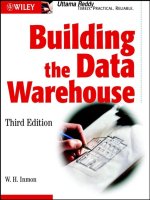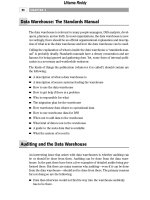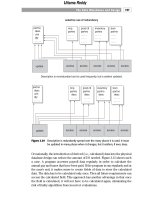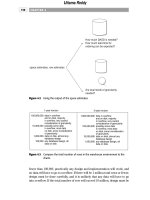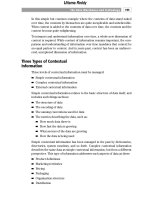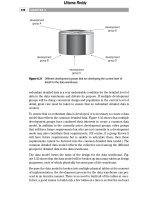Building the Data Warehouse Third Edition phần 5 pptx
Bạn đang xem bản rút gọn của tài liệu. Xem và tải ngay bản đầy đủ của tài liệu tại đây (449.98 KB, 43 trang )
fewer than 100,000, practically any design and implementation will work, and
no data will have to go to overflow. If there will be 1 million total rows or fewer,
design must be done carefully, and it is unlikely that any data will have to go
into overflow. If the total number of row will exceed 10 million, design must be
CHAPTER 4
150
space estimates, row estimates
How much DASD is needed?
How much lead time for
ordering can be expected?
Are dual levels of granularity
needed?
Figure 4.2 Using the output of the space estimates.
1-year horizon
5-year horizon
1,000,000,000 data in overflow
and on disk, majority
in overflow, very careful
consideration of granularity
100,000,000 possibly some data
in overflow, most data
on disk, some consideration
of granularity
10,000,000 data on disk, almost any
database design
1,000,000 any database design, all
data on disk
100,000,000 data in overflow
and on disk, majority
in overflow, very careful
consideration of granularity
10,000,000 possibly some data
in overflow, most data
on disk, some consideration
of granularity
1,000,000 data on disk, almost any
database design
100,000 any database design, all
data on disk
Figure 4.3 Compare the total number of rows in the warehouse environment to the
charts.
Uttama Reddy
done carefully, and it is likely that at least some data will go to overflow. And if
the total number of rows in the data warehouse environment is to exceed 100
million rows, surely a large amount of data will go to overflow storage, and a
very careful design and implementation of the data warehouse is required.
On the five-year horizon, the totals shift by about an order of magnitude. The
theory is that after five years these factors will be in place:
■■
There will be more expertise available in managing the data warehouse
volumes of data.
■■
Hardware costs will have dropped to some extent.
■■
More powerful software tools will be available.
■■
The end user will be more sophisticated.
All of these factors point to a different volume of data that can be managed over
a long period of time. Unfortunately, it is almost impossible to accurately fore-
cast the volume of data into a five-year horizon. Therefore, this estimate is used
as merely a raw guess.
An interesting point is that the total number of bytes used in the warehouse has
relatively little to do with the design and granularity of the data warehouse. In
other words, it does not particularly matter whether the record being considered
is 25 bytes long or 250 bytes long. As long as the length of the record is of rea-
sonable size, then the chart shown in Figure 4.3 still applies. Of course, if the
record being considered is 250,000 bytes long, then the length of the record
makes a difference. Not many records of that size are found in the data ware-
house environment, however. The reason for the indifference to record size has
as much to do with the indexing of data as anything else. The same number of
index entries is required regardless of the size of the record being indexed. Only
under exceptional circumstances does the actual size of the record being indexed
play a role in determining whether the data warehouse should go into overflow.
Overflow Storage
Data in the data warehouse environment grows at a rate never before seen by
IT professionals. The combination of historical data and detailed data produces
a growth rate that is phenomenal. The terms terabyte and petabyte were used
only in theory prior to data warehousing.
As data grows large a natural subdivision of data occurs between actively used
data and inactively used data. Inactive data is sometimes called dormant data.
At some point in the life of the data warehouse, the vast majority of the data in
the warehouse becomes stale and unused. At this point it makes sense to start
separating the data onto different storage media.
Granularity in the Data Warehouse
151
Uttama Reddy
Most professionals have never built a system on anything but disk storage. But
as the data warehouse grows large, it simply makes economic and technologi-
cal sense to place the data on multiple storage media. The actively used portion
of the data warehouse remains on disk storage, while the inactive portion of the
data in the data warehouse is placed on alternative storage or near-line storage.
Data that is placed on alternative or near-line storage is stored much less
expensively than data that resides on disk storage. And just because data is
placed on alternative or near-line storage does not mean that the data is inac-
cessible. Data placed on alternate or near-line storage is just as accessible as
data placed on disk storage. By placing inactive data on alternate or near-line
storage, the architect removes impediments to performance from the high-
performance active data. In fact, moving data to near-line storage greatly accel-
erates the performance of the entire environment.
To make data accessible throughout the system and to place the proper data in
the proper part of storage, software support of the alternate storage/near-line
environment is needed. Figure 4.4 shows some of the more important compo-
nents of the support infrastructure needed for the alternate storage/near-line
storage environment.
Figure 4.4 shows that a data monitor is needed to determine the usage of data.
The data monitor tells where to place data. The movement between disk stor-
age and near-line storage is controlled by means of software called a cross-
media storage manager. The data in alternate storage/near-line storage can be
accessed directly by means of software that has the intelligence to know where
data is located in near-line storage. These three software components are the
minimum required for alternate storage/near-line storage to be used effectively.
In many regards alternate storage/near-line storage acts as overflow storage for
the data warehouse. Logically, the data warehouse extends over both disk stor-
age and alternate storage/near-line storage in order to form a single image of
data. Of course, physically the data may be placed on any number of volumes of
data.
An important component of the data warehouse is overflow storage, where
infrequently used data is held. Overflow storage has an important effect on
granularity. Without this type of storage, the designer is forced to adjust the
level of granularity to the capacity and budget for disk technology. With over-
flow storage the designer is free to create as low a level of granularity as
desired.
Overflow storage can be on any number of storage media. Some of the popular
media are photo optical storage, magnetic tape (sometimes called “near-line
storage”), and cheap disk. The magnetic tape storage medium is not the same
as the old-style mag tapes with vacuum units tended by an operator. Instead,
CHAPTER 4
152
Uttama Reddy
the modern rendition is a robotically controlled silo of storage where the
human hand never touches the storage unit.
The alternate forms of storage are cheap, reliable, and capable of storing huge
amounts of data, much more so than is feasible for storage on high-performance
disk devices—the alternate of storage. In doing so, the alternate forms of stor-
age as overflow for the data warehouse allow. In some cases, a query facility
that can operate independently of the storage device is desirable. In this case
when a user makes a query there is no prior knowledge of where the data
resides. The query is issued, and the system then finds the data regardless of
where it is.
While it is convenient for the end user to merely “go get the data,” there is a per-
formance implication. If the end user frequently accesses data that is in alter-
nate storage, the query will not run quickly, and many machine resources will
be consumed in the servicing of the request. Therefore, the data architect is
best advised to make sure that the data that resides in alternate storage is
accessed infrequently.
There are several ways to ensure infrequently accessed data resides in alternate
storage. A simple way is to place data in alternate storage when it reaches a
certain age—say, 24 months. Another way is to place certain types of data in
Granularity in the Data Warehouse
153
monitor data warehouse use
cross-media storage management
near-line/alternative storage
direct access and analysis
Figure 4.4 The support software needed to make storage overflow possible.
Uttama Reddy
alternate storage and other types in disk storage. Monthly summary of cus-
tomer records may be placed in disk storage, while details that support the
monthly summary are placed in alternate storage.
In other cases of query processing, separating the disk-based queries from the
alternate-storage-based queries is desirable. Here, one type of query goes
against disk-based storage and another type goes against alternate storage. In
this case, there is no need to worry about the performance implications of a
query having to fetch alternate-storage-based data.
This sort of query separation can be advantageous—particularly with regard to
protecting systems resources. Usually the types of queries that operate against
alternate storage end up accessing huge amounts of data. Because these long-
running activities are performed in a completely separate environment, the
data administrator never has to worry about query performance in the disk-
based environment.
For the overflow storage environment to operate properly, several types of
software become mandatory. Figure 4.5 shows these types and where they are
positioned.
CHAPTER 4
154
cross-media
storage manager
activity
monitor
Figure 4.5 For overflow storage to function properly, at least two types of software are
needed—a cross-media storage manager and an activity monitor.
Uttama Reddy
Figure 4.5 shows that two pieces of software are needed for the overflow envi-
ronment to operate properly—a cross-media storage manager and an activity
monitor. The cross-media storage manager manages the traffic of data going to
and from the disk storage environment to the alternate storage environment.
Data moves from the disk to alternate storage when it ages or when its proba-
bility of access drops. Data from the alternate storage environment can be
moved to disk storage when there is a request for the data or when it is detected
that there will be multiple future requests for the data. By moving the data to
and from disk storage to alternate storage, the data administrator is able to get
maximum performance from the system.
The second piece required, the activity monitor, determines what data is and is
not being accessed. The activity monitor supplies the intelligence to determine
where data is to be placed—on disk storage or on alternate storage.
What the Levels of Granularity Will Be
Once the simple analysis is done (and, in truth, many companies discover that
they need to put at least some data into overflow storage), the next step is to
determine the level of granularity for data residing on disk storage. This step
requires common sense and a certain amount of intuition. Creating a disk-based
data warehouse at a very low level of detail doesn’t make sense because too
many resources are required to process the data. On the other hand, creating a
disk-based data warehouse with a level of granularity that is too high means
that much analysis must be done against data that resides in overflow storage.
So the first cut at determining the proper level of granularity is to make an edu-
cated guess.
Such a guess is only the starting point, however. To refine the guess, a certain
amount of iterative analysis is needed, as shown in Figure 4.6. The only real way
to determine the proper level of granularity for the lightly summarized data is to
put the data in front of the end user. Only after the end user has actually seen
the data can a definitive answer be given. Figure 4.6 shows the iterative loop
that must transpire.
The second consideration in determining the granularity level is to anticipate
the needs of the different architectural entities that will be fed from the data
warehouse. In some cases, this determination can be done scientifically. But, in
truth, this anticipation is really an educated guess. As a rule, if the level of gran-
ularity in the data warehouse is small enough, the design of the data warehouse
will suit all architectural entities. Data that is too fine can always be summa-
rized, whereas data that is not fine enough cannot be easily broken down.
Therefore, the data in the data warehouse needs to be at the lowest common
denominator.
Granularity in the Data Warehouse
155
Uttama Reddy
Some Feedback Loop Techniques
Following are techniques to make the feedback loop harmonious:
■■
Build the first parts of the data warehouse in very small, very fast steps,
and carefully listen to the end users’ comments at the end of each step of
development. Be prepared to make adjustments quickly.
■■
If available, use prototyping and allow the feedback loop to function using
observations gleaned from the prototype.
■■
Look at how other people have built their levels of granularity and learn
from their experience.
■■
Go through the feedback process with an experienced user who is aware
of the process occurring. Under no circumstances should you keep your
users in the dark as to the dynamics of the feedback loop.
■■
Look at whatever the organization has now that appears to be working,
and use those functional requirements as a guideline.
CHAPTER 4
156
designs,
populates
developer
reports/
analysis
• building very small subsets quickly and carefully listening to feedback
• prototyping
• looking at what other people have done
• working with an experienced user
• looking at what the organization has now
• JAD sessions with simulated output
data
warehouse
DSS
analysts
Rule of Thumb:
If 50% of the first iteration of design is correct, the design effort has been a success.
Figure 4.6 The attitude of the end user: ”Now that I see what can be done, I can tell
you what would really be useful.”
Uttama Reddy
■■
Execute joint application design (JAD) sessions and simulate the output in
order to achieve the desired feedback.
Granularity of data can be raised in many ways, such as the following:
■■
Summarize data from the source as it goes into the target.
■■
Average or otherwise calculate data as it goes into the target.
■■
Push highest/lowest set values into the target.
■■
Push only data that is obviously needed into the target.
■■
Use conditional logic to select only a subset of records to go into the
target.
The ways that data may be summarized or aggregated are limitless.
When building a data warehouse, keep one important point in mind. In classical
requirements systems development, it is unwise to proceed until the vast major-
ity of the requirements are identified. But in building the data warehouse, it is
unwise not to proceed if at least half of the requirements for the data ware-
house are identified. In other words, if in building the data warehouse the devel-
oper waits until many requirements are identified, the warehouse will never be
built. It is vital that the feedback loop with the DSS analyst be initiated as soon
as possible.
As a rule, when transactions are created in business they are created from lots
of different types of data. An order contains part information, shipping infor-
mation, pricing, product specification information, and the like. A banking
transaction contains customer information, transaction amounts, account
information, banking domicile information, and so forth. When normal busi-
ness transactions are being prepared for placement in the data warehouse, their
level of granularity is too high, and they must be broken down into a lower
level. The normal circumstance then is for data to be broken down. There are at
least two other circumstances in which data is collected at too low a level of
granularity for the data warehouse, however:
■■
Manufacturing process control. Analog data is created as a by-product of
the manufacturing process. The analog data is at such a deep level of gran-
ularity that it is not useful in the data warehouse. It needs to be edited and
aggregated so that its level of granularity is raised.
■■
Clickstream data generated in the Web environment. Web logs collect
clickstream data at a granularity that it is much too fine to be placed in the
data warehouse. Clickstream data must be edited, cleansed, resequenced,
summarized, and so forth before it can be placed in the warehouse.
These are a few notable exceptions to the rule that business-generated data is
at too high a level of granularity.
Granularity in the Data Warehouse
157
Uttama Reddy
Levels of Granularity—Banking Environment
Consider the simple data structures shown in Figure 4.7 for a banking/financial
environment.
To the left—at the operational level—is operational data, where the details of
banking transactions are found. Sixty days’ worth of activity are stored in the
operational online environment.
In the lightly summarized level of processing—shown to the right of the opera-
tional data—are up to 10 years’ history of activities. The activities for an
account for a given month are stored in the lightly summarized portion of the
data warehouse. While there are many records here, they are much more com-
pact than the source records. Much less DASD and many fewer rows are found
in the lightly summarized level of data.
Of course, there is the archival level of data (i.e., the overflow level of data), in
which every detailed record is stored. The archival level of data is stored on a
medium suited to bulk management of data. Note that not all fields of data are
transported to the archival level. Only those fields needed for legal reasons,
informational reasons, and so forth are stored. The data that has no further use,
even in an archival mode, is purged from the system as data is passed to the
archival level.
The overflow environment can be held in a single medium, such as magnetic
tape, which is cheap for storage and expensive for access. It is entirely possible
to store a small part of the archival level of data online, when there is a proba-
bility that the data might be needed. For example, a bank might store the most
recent 30 days of activities online. The last 30 days is archival data, but it is still
online. At the end of the 30-day period, the data is sent to magnetic tape, and
space is made available for the next 30 days’ worth of archival data.
Now consider another example of data in an architected environment in the
banking/financial environment. Figure 4.8 shows customer records spread
across the environment. In the operational environment is shown current-value
data whose content is accurate as of the moment of usage. The data that exists
at the light level of summarization is the same data (in terms of definition of
data) but is taken as a snapshot once a month.
Where the customer data is kept over a long span of time—for the past 10 years-
a continuous file is created from the monthly files. In such a fashion the history
of a customer can be tracked over a lengthy period of time.
Now let’s move to another industry—manufacturing. In the architected
environment shown in Figure 4.9, at the operational level is the record of
CHAPTER 4
158
TEAMFLY
Team-Fly
®
Uttama Reddy
Granularity in the Data Warehouse
159
account
activity date
amount
teller
location
to whom
identification
account balance
instrument number
dual levels of granularity in the banking environment
monthly account register—
up to 10 years
account
month
number of transactions
withdrawals
deposits
beg balance
end balance
account high
account low
average account balance
account
activity date
amount
to whom
identification
account balance
instrument number
60 days worth
of activity
operational
Figure 4.7 A simple example of dual levels of granularity in the banking environment.
Uttama Reddy
CHAPTER 4
160
dual levels of granularity in the banking environment
customer ID
name
address
phone
employer
credit rating
monthly income
dependents
own home?
occupation
current
customer data
last month’s
customer file
continuous customer
record—last ten years
customer ID
name
address
phone
employer
credit rating
monthly income
dependents
own home?
occupation
customer ID
from date
to date
name
address
credit rating
monthly income
own home?
occupation
Figure 4.8 Another form of dual levels of granularity in the banking environment.
Uttama Reddy
Granularity in the Data Warehouse
161
part no
date
qty
by assembly
to assembly
work order manifest
dropout rate
on time?
storage location
responsible foreman
dual levels of granularity in the manufacturing environment
assembly record 1 year’s history
part no
date
total qty completed
total qty used
total dropout
lots complete on time
lots complete late
assembly ID
part no
date
total qty
number lots
on time
late
part no
date
qty
by assembly
to assembly
work order manifest
dropout rate
on time?
responsible foreman
cumulative production
90 days stored
true archival level
daily production
30 days stored
Figure 4.9 Some of the different levels of granularity in a manufacturing environment.
Uttama Reddy
manufacture upon the completion of an assembly for a given lot of parts.
Throughout the day many records aggregate as the assembly process runs.
The light level of summarization contains two tables—one for all the activities
for a part summarized by day, another by assembly activity by part. The parts’
cumulative production table contains data for up to 90 days. The assembly
record contains a limited amount of data on the production activity summa-
rized by date.
The archival/overflow environment contains a detailed record of each manu-
facture activity. As in the case of a bank, only those fields that will be needed
later are stored. (Actually, those fields that have a reasonable probability of
being needed later are stored.)
Another example of data warehouse granularity in the manufacturing environ-
ment is shown in Figure 4.10, where an active-order file is in the operational
environment. All orders that require activity are stored there. In the data ware-
house is stored up to 10 years’ worth of order history. The order history is keyed
on the primary key and several secondary keys. Only the data that will be
needed for future analysis is stored in the warehouse. The volume of orders
CHAPTER 4
162
order no
customer
part no
amount
date of order
delivery date
ship to
expedite
cost
contact
shipping unit
levels of granularity in the manufacturing environment
indexed
separately
order no
customer
part no
amount
date of order
delivery date
ship to
expedite
cost
contact
shipping unit
active orders up
to 2 years
10 years’ order
history
order no
date of order
customer
part no
amount
cost
late delivery?
Figure 4.10 There are so few order records that there is no need for a dual level of
granularity.
Uttama Reddy
was so small that going to an overflow level was not necessary. Of course,
should orders suddenly increase, it may be necessary to go to a lower level of
granularity and into overflow.
Another adaptation of a shift in granularity is seen in the data in the architected
environment of an insurance company, shown in Figure 4.11. Premium pay-
ment information is collected in an active file. Then, after a period of time, the
information is passed to the data warehouse. Because only a relatively small
amount of data exists, overflow data is not needed. However, because of the
regularity of premium payments, the payments are stored as part of an array in
the warehouse.
As another example of architecture in the insurance environment, consider the
insurance claims information shown in Figure 4.12. In the current claims system
(the operational part of the environment), much detailed information is stored
about claims. When a claim is settled (or when it is determined that a claim is not
going to be settled), or when enough time passes that the claim is still pending,
Granularity in the Data Warehouse
163
dual levels of granularity in the insurance environment
policy no
premium date
late date
amount
adjustments
premium payments
(active)
premium history
10 years
policy no
year
premium-1
date due
date paid
amount
late charge
premium-2
date due
date paid
amount
late charge
Figure 4.11 Because of the low volume of premiums, there is no need for dual levels of
granularity, and because of the regularity of premium billing, there is the
opportunity to create an array of data.
Uttama Reddy
CHAPTER 4
164
claim no
policy no
date of claim
amount
settlement offered
type of claim
no fault
settlement accepted
reason not
accepted
arbitration?
damage estimate
loss estimate
uninsured loss
coinsurance?
claim no
policy no
date of claim
amount
settlement offered
type of claim
no fault
settlement accepted
reason not accepted
arbitration?
damage estimate
loss estimate
uninsured loss
coinsurance?
agent
month
total claims
total amount
settlements
type of claim
month
total claims
total amount
single largest
settlement
dual levels of granularity in the insurance environment
agent/claims by month
10 years
agent/claims by month
10 years
current claims
true archival,
unlimited time
Figure 4.12 Claims information is summarized on other than the primary key in the
lightly summarized part of the warehouse. Claims information must be
kept indefinitely in the true archival portion of the architecture.
Uttama Reddy
the claim information passes over to the data warehouse. As it does so, the claim
information is summarized in several ways—by agent by month, by type of claim
by month, and so on. At a lower level of detail, the claim is held in overflow stor-
age for an unlimited amount of time. As in the other cases in which data passes
to overflow, only data that might be needed in the future is kept (which is most
of the information found in the operational environment).
Summary
Choosing the proper levels of granularity for the architected environment is
vital to success. The normal way the levels of granularity are chosen is to use
common sense, create a small part of the warehouse, and let the user access the
data. Then listen very carefully to the user, take the feedback he or she gives,
and adjust the levels of granularity appropriately.
The worst stance that can be taken is to design all the levels of granularity a pri-
ori, then build the data warehouse. Even in the best of circumstances, if 50 per-
cent of the design is done correctly, the design is a good one. The nature of the
data warehouse environment is such that the DSS analyst cannot envision what
is really needed until he or she actually sees the reports.
The process of granularity design begins with a raw estimate of how large the
warehouse will be on the one-year and the five-year horizon. Once the raw esti-
mate is made, then the estimate tells the designer just how fine the granularity
should be. In addition, the estimate tells whether overflow storage should be
considered.
There is an important feedback loop for the data warehouse environment.
Upon building the data warehouse’s first iteration, the data architect listens
very carefully to the feedback from the end user. Adjustments are made based
on the user’s input.
Another important consideration is the levels of granularity needed by the dif-
ferent architectural components that will be fed from the data warehouse.
When data goes into overflow—away from disk storage to a form of alternate
storage—the granularity can be as low as desired. When overflow storage is not
used, the designer will be constrained in the selection of the level of granularity
when there is a significant amount of data.
For overflow storage to operate properly, two pieces of software are neces-
sary—a cross-media storage manager that manages the traffic to and from the
disk environment to the alternate storage environment and an activity monitor.
The activity monitor is needed to determine what data should be in overflow
and what data should be on disk.
Granularity in the Data Warehouse
165
Uttama Reddy
Uttama Reddy
The Data Warehouse
and Technology
CHAPTER
5
I
n many ways, the data warehouse requires a simpler set of technological fea-
tures than its predecessors. Online updating with the data warehouse is not
needed, locking needs are minimal, only a very basic teleprocessing interface is
required, and so forth. Nevertheless, there are a fair number of technological
requirements for the data warehouse. This chapter outlines some of these.
Managing Large Amounts of Data
Prior to data warehousing the terms terabytes and petabytes were unknown;
data capacity was measured in megabytes and gigabytes. After data warehous-
ing the whole perception changed. Suddenly what was large one day was tri-
fling the next. The explosion of data volume came about because the data
warehouse required that both detail and history be mixed in the same environ-
ment. The issue of volumes of data is so important that it pervades all other
aspects of data warehousing. With this in mind, the first and most important
technological requirement for the data warehouse is the ability to manage large
amounts of data, as shown in Figure 5.1. There are many approaches, and in a
large warehouse environment, more than one approach will be used.
Large amounts of data need to be managed in many ways—through flexibility
of addressability of data stored inside the processor and stored inside disk
167
Uttama Reddy
storage, through indexing, through extensions of data, through the efficient
management of overflow, and so forth. No matter how the data is managed,
however, two fundamental requirements are evident—the ability to manage
large amounts at all and the ability to manage it well. Some approaches can be
used to manage large amounts of data but do so in a clumsy manner. Other
approaches can manage large amounts and do so in an efficient, elegant man-
CHAPTER 5
168
First technological requirement—
the ability to manage volumes of
data
Second technological requirement—
to be able to manage multiple
media
Third technological requirement—
to be able to index and montor
data freely and easily
Fourth technological requirement—
to interface—both receiving data
from and passing data to a wide
variety of technologies
index
report
Figure 5.1 Some basic requirements for technology supporting a data warehouse.
TEAMFLY
Team-Fly
®
Uttama Reddy
ner. To be effective, the technology used must satisfy the requirements for both
volume and efficiency.
In the ideal case, the data warehouse developer builds a data warehouse under
the assumption that the technology that houses the data warehouse can handle
the volumes required. When the designer has to go to extraordinary lengths in
design and implementation to map the technology to the data warehouse, then
there is a problem with the underlying technology. When technology is an issue,
it is normal to engage more than one technology. The ability to participate in
moving dormant data to overflow storage is perhaps the most strategic capa-
bility that a technology can have.
Of course, beyond the basic issue of technology and its efficiency is the cost of
storage and processing.
Managing Multiple Media
In conjunction with managing large amounts of data efficiently and cost-
effectively, the technology underlying the data warehouse must handle multiple
storage media. It is insufficient to manage a mature data warehouse on Direct
Access Storage Device (DASD) alone. Following is a hierarchy of storage of
data in terms of speed of access and cost of storage:
Main memory Very fast Very expensive
Expanded memory Very fast Expensive
Cache Very fast Expensive
DASD Fast Moderate
Magnetic tape Not fast Not expensive
Optical disk Not slow Not expensive
Fiche Slow Cheap
The volume of data in the data warehouse and the differences in the probability
of access dictates that a fully populated data warehouse reside on more than
one level of storage.
Index/Monitor Data
The very essence of the data warehouse is the flexible and unpredictable
access of data. This boils down to the ability to access the data quickly and eas-
ily. If data in the warehouse cannot be easily and efficiently indexed, the data
warehouse will not be a success. Of course, the designer uses many practices to
The Data Warehouse and Technology
169
Uttama Reddy
make data as flexible as possible, such as spreading data across different stor-
age media and partitioning data. But the technology that houses the data must
be able to support easy indexing as well. Some of the indexing techniques that
often make sense are the support of secondary indexes, the support of sparse
indexes, the support of dynamic, temporary indexes, and so forth. Further-
more, the cost of creating the index and using the index cannot be significant.
In the same vein, the data must be monitored at will. The cost of monitoring
data cannot be so high and the complexity of monitoring data so great as to
inhibit a monitoring program from being run whenever necessary. Unlike the
monitoring of transaction processing, where the transactions themselves are
monitored, data warehouse activity monitoring determines what data has and
has not been used.
Monitoring data warehouse data determines such factors as the following:
■■
If a reorganization needs to be done
■■
If an index is poorly structured
■■
If too much or not enough data is in overflow
■■
The statistical composition of the access of the data
■■
Available remaining space
If the technology that houses the data warehouse does not support easy and
efficient monitoring of data in the warehouse, it is not appropriate.
Interfaces to Many Technologies
Another extremely important component of the data warehouse is the ability
both to receive data from and to pass data to a wide variety of technologies.
Data passes into the data warehouse from the operational environment and the
ODS, and from the data warehouse into data marts, DSS applications, explo-
ration and data mining warehouses, and alternate storage. This passage must
be smooth and easy. The technology supporting the data warehouse is practi-
cally worthless if there are major constraints for data passing to and from the
data warehouse.
In addition to being efficient and easy to use, the interface to and from the data
warehouse must be able to operate in a batch mode. Operating in an online
mode is interesting but not terribly useful. Usually a period of dormancy exists
from the moment that the data arrives in the operational environment until the
data is ready to be passed to the data warehouse. Because of this latency, online
passage of data into the data warehouse is almost nonexistent (as opposed to
online movement of data into a class I ODS).
CHAPTER 5
170
Uttama Reddy
The interface to different technologies requires several considerations:
■■
Does the data pass from one DBMS to another easily?
■■
Does it pass from one operating system to another easily?
■■
Does it change its basic format in passage (EBCDIC, ASCII, etc.)?
Programmer/Designer Control
of Data Placement
Because of efficiency of access and update, the programmer/designer must
have specific control over the placement of data at the physical block/page
level, as shown in Figure 5.2.
The technology that houses the data in the data warehouse can place the data
where it thinks is appropriate, as long as the technology can be explicitly over-
ridden when needed. Technology that insists on the physical placement of data
with no overrides from the programmer is a serious mistake.
The programmer/designer often can arrange for the physical placement of data
to coincide with its usage. In doing so, many economies of resource utilization
can be gained in the access of data.
Parallel Storage/Management of Data
One of the most powerful features of data warehouse data management is par-
allel storage/management. When data is stored and managed in a parallel fash-
ion, the gains in performance can be dramatic. As a rule, the performance boost
is inversely proportional to the number of physical devices over which the data
is scattered, assuming there is an even probability of access for the data.
The entire issue of parallel storage/management of data is too complex and
important to be discussed at length here, but it should be mentioned.
Meta Data Management
As mentioned in Chapter 3, for a variety of reasons, meta data becomes even
more important in the data warehouse than in the classical operational envi-
ronment. Meta data is vital because of the fundamental difference in the devel-
opment life cycle that is associated with the data warehouse. The data
warehouse operates under a heuristic, iterative development life cycle. To be
effective, the user of the data warehouse must have access to meta data that is
accurate and up-to-date. Without a good source of meta data to operate from,
The Data Warehouse and Technology
171
Uttama Reddy
the job of the DSS analyst is much more difficult. Typically, the technical meta
data that describes the data warehouse contains the following:
■■
Data warehouse table structures
■■
Data warehouse table attribution
■■
Data warehouse source data (the system of record)
CHAPTER 5
172
Fifth technological requirement—
to allow the designer/developer
to physically place the data—at
the block/page level—in an
optimal fashion
Sixth technological requirement—
to manage data in parallel
Seventh technological requirement—
to have solid meta data control
Eighth technological requirement—
to have a rich language interface
to the data warehouse
designer
meta data
language
Figure 5.2 More technological requirements for the data warehouse.
Uttama Reddy
■■
Mapping from the system of record to the data warehouse
■■
Data model specification
■■
Extract logging
■■
Common routines for access of data
■■
Definitions/descriptions of data
■■
Relationships of one unit of data to another
Several types of meta data need to be managed in the data warehouse: distrib-
uted meta data, central meta data, technical meta data, and business meta data.
Each of these categories of meta data has its own considerations.
Language Interface
The data warehouse must have a rich language specification. The languages
used by the programmer and the DSS end user to access data inside the data
warehouse should be easy to use and robust. Without a robust language, enter-
ing and accessing data in the warehouse become difficult. In addition, the lan-
guage used to access data needs to operate efficiently.
Typically, the language interface to the data warehouse should do the following:
■■
Be able to access data a set at a time
■■
Be able to access data a record at a time
■■
Specifically ensure that one or more indexes will be used in the satisfac-
tion of a query
■■
Have an SQL interface
■■
Be able to insert, delete, or update data
There are, in fact, many different kinds of languages depending on the process-
ing being performed. These include languages for statistical analysis of data,
where data mining and exploration are done; languages for the simple access of
data; languages that handle prefabricated queries; and languages that optimize
on the graphic nature of the interface. Each of these languages has its own
strengths and weaknesses.
Efficient Loading of Data
An important technological capability of the data warehouse is to load the data
warehouse efficiently, as shown in Figure 5.3. The need for an efficient load is
important everywhere, but even more so in a large warehouse.
The Data Warehouse and Technology
173
Uttama Reddy
Data is loaded into a data warehouse in two fundamental ways: a record at a
time through a language interface or en masse with a utility. As a rule, loading
data by means of a utility is much faster. In addition, indexes must be efficiently
loaded at the same time the data is loaded. In some cases, the loading of the
indexes may be deferred in order to spread the workload evenly.
CHAPTER 5
174
Ninth technological requirement—
to be able to load the warehouse
efficiently
Tenth technological requirement—
to use indexes efficiently
Eleventh technological requirement—
to be able to store data in a
compact way
Twelfth technological requirement—
to support compound keys
XXXXX
XXXX
XXXXXXX
XXXXXXXX
XXXX
XXXXXXXX
XX
XXXXXXXX
Figure 5.3 Further technological requirements.
Uttama Reddy
